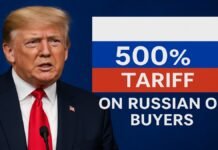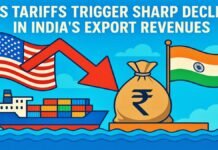
Key Points
- Indian refiners boosted Russian crude imports from 1.7% of total in FY20 to 35.1% in FY25, chasing discounts and higher refining margins.
- US has imposed additional 25% tariffs on Indian goods over Russian oil purchases, taking total tariffs to 50% with effect after a 21‑day window; India calls it “unjustified and unreasonable”.
- Govt data indicates savings of about $25B (≈₹1.64 lakh crore) in 2023‑24 due to lower crude prices and discounted Russian oil, even with similar import volumes.
- Analysts estimate India’s oil import bill could rise by $9–12B if Russian crude imports stop, and global crude could jump ~10% if Russia is broadly shut out.
- Benefits from discounts largely bolster refiner margins and tax revenues, while pump prices remain sticky due to pricing practices and tax needs.
New Delhi: Since 2022, India scaled up purchases of discounted Russian crude, making Russia its top supplier and lifting the share of imports to 35.1% in FY25 from just 1.7% in FY20, aided by compatibility of Urals with India’s complex refineries and strong distillate yields. Government figures show India spent $132.4B on crude in 2023‑24 versus $157.5B in 2022‑23, implying savings of over $25B (≈₹1.64 lakh crore) driven by lower global prices and discounted Russian barrels, even as import volumes stayed broadly flat.
Meanwhile, the US has moved to penalize India’s continued intake of Russian oil, doubling cumulative tariffs on Indian goods to 50% via an additional 25% levy, slated to kick in after a 21‑day window; New Delhi has condemned the step and signaled it will protect national interests.
1) Why Isn’t the Common Man Seeing Cheaper Pump Prices?
- Retail fuel prices in India remain effectively policy‑managed despite formal deregulation, with government excise/VAT needs and OMC pricing behavior limiting pass‑through of import discounts to consumers; the margin gains and fiscal take have been prioritized to stabilize finances and OMC balance sheets after earlier subsidy losses.
- The result: refiners maintain strong margins from discounted crude and favorable yields, while government revenues benefit from taxes—even as retail prices stay largely unchanged for long periods.
2) How Much Have Oil Companies Gained?
- The shift to discounted Urals enabled both state‑owned and private refiners to run above nameplate capacity and preserve strong margins due to high distillate yields, boosting profitability across the sector.
- Expanded Russian intake to 88MMT out of 245MMT total in FY25 underpins the margin story, with private players like Reliance and Nayara, alongside IOC/BPCL/HPCL, leveraging the discount to lift refining economics and exports.
3) Why Won’t India Stop Buying Russian Oil?
- Cheaper barrels: Discounts once as high as $20–30/bbl at peaks have narrowed to about $3–6/bbl recently, but still support margins and reduce the import bill; govt data pegs FY24 savings at over $25B due to price/mix effects.
- Energy security and price stability: Maintaining diversified supply, including Russia, helps stabilize domestic prices/inflation; abrupt cessation risks higher costs and volatility.
- Global impact: Russia supplies ~10% of world crude; broad exclusion could lift global prices by ~10% if no compensating output appears, raising India’s bill by an estimated $9–12B if it pivots away.
Trade and Geopolitics: The US Tariff Shock
- The US has imposed a fresh 25% tariff on Indian goods, taking total duties to 50%, citing India’s Russian oil purchases; implementation follows a 21‑day window, with India denouncing the move and weighing responses.
- Markets currently appear skeptical the threats will drastically curtail India’s Russian intake, but compliance and cost risks have risen; New Delhi is assessing options while reinforcing its energy security stance.
What It Means Next
- For consumers: Unless tax policy or pricing practices change, retail relief remains limited despite discounted crude, as authorities balance fiscal needs with inflation management.
- For refiners: Narrower discounts pressure margins but remain positive; complex refineries retain an edge due to Urals compatibility and export opportunities.
- For the exchequer: Continued inflows from fuel taxation and export earnings cushion external shocks, but higher US tariffs may hit other export sectors, complicating the macro trade‑off.


















































